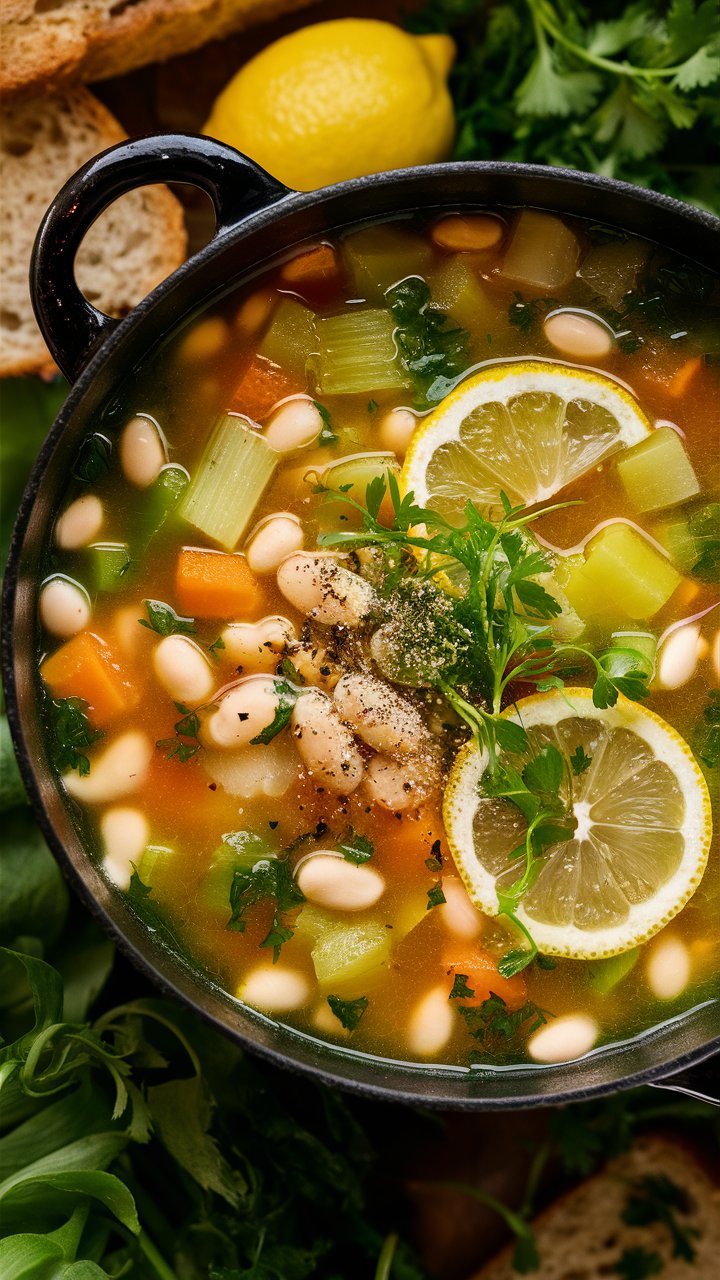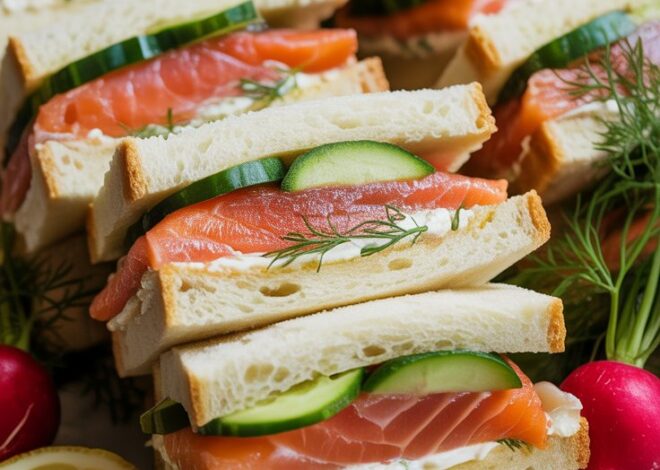
Easy White Bean Vegetable Soup – A One-Pot Dinner Favorite 2025
When you think of comfort food in a bowl, few dishes hit as many satisfying notes as white bean vegetable soup. It’s hearty, but light; nutritious, but comforting. What’s more, it’s highly adaptable—perfect for weeknights, for batch cooking, and for stretching pantry staples.
But beyond comfort, this soup offers a smart balance: fiber, plant protein, vitamins from vegetables, and soothing warmth on colder days. In this article, you’ll get not just a recipe, but deep insight into why it works (and how to make it your own).
Whether you’re a seasoned cook or a kitchen beginner, by the end you’ll feel confident whipping up your own version—and tweaking it to your taste, diet, or what’s in your fridge.
2. Health Benefits & Nutrition Snapshot
Before diving into cooking, it helps to understand why this soup is a smart choice:
2.1 Bean Power: Fiber + Plant Protein
White beans (such as cannellini, navy, or great northern) are excellent sources of dietary fiber and plant protein. This combination helps promote fullness, stabilizes digestion, and supports blood sugar balance.
2.2 Nutrient Boost from Vegetables
Adding vegetables—onion, carrot, celery, maybe greens like spinach or kale—brings in vitamins (A, C, K), minerals (potassium, magnesium), and antioxidants.
2.3 Low in Saturated Fat
If prepared without heavy creams or excess butter, this soup is naturally low in saturated fat, making it heart-friendly.
2.4 Customizable for Special Diets
You can make the soup vegan, gluten-free, low sodium, or even add lean proteins (chicken, turkey) or whole grains (quinoa, barley) to tailor it to your goals.
2.5 Approximate Nutrition (Per Serving)
Here’s a rough estimate for one medium bowl (without added meat or extra grains):
- Calories: ~200–250
- Protein: 10–14 g
- Fiber: 6–10 g
- Fat: 3–5 g (mostly from olive oil)
- Carbohydrates: 25–35 g
(Actual values will vary based on ingredient choices.)
3. Ingredients: What You’ll Need & Why
Below is a breakdown of typical ingredients, with commentary on purpose and optional alternatives.
| Ingredient | Approx. Amount* | Role / Notes | Possible Substitutes |
|---|---|---|---|
| Olive oil | 1–2 tbsp | For sautéing vegetables | Avocado oil, light olive oil |
| Butter (optional) | 1 tbsp | Adds richness, especially if not vegan | Omit or use vegan butter |
| Onion | 1 medium (diced) | Base aromatics | Shallot, leek |
| Carrots | 2 medium (diced) | Sweetness, texture | Parsnip, sweet potato |
| Celery | 2 stalks (diced) | Aromatic backbone | Fennel stalks or omit if disliked |
| Garlic | 2–4 cloves (minced) | Depth of flavor | Garlic paste, garlic powder (in pinch) |
| Italian seasoning (or blend of dried herbs) | ~2 tsp | Herb notes (oregano, thyme, basil) | Individual fresh herbs |
| Salt & Pepper | to taste | Essential for seasoning | Adjust carefully to preference |
| Vegetable or Chicken Broth | 4–6 cups | Liquid base | Homemade stock, low-sodium broth |
| Parmesan rind (optional) | 1 piece | Adds savory umami (remove before serving) | Skip for vegan version |
| White beans (canned or cooked) | 2 cans (15 oz) or ~2–3 cups cooked | Main protein + texture | Other types of beans |
| Fresh herbs (for garnish) | parsley, rosemary, or basil | Bright finishing flavor | Chives, dill |
| Grated Parmesan cheese (optional) | for topping | Final finishing touch | Vegan Parmesan or nutritional yeast |
* Quantities are estimates—see the recipe section for precise measurements.
Why each major ingredient matters:
- Vegetables (onion, carrot, celery, garlic): These create flavor depth through the sofrito / mirepoix base.
- Broth + rind: The broth carries flavor; a Parmesan rind (if used) deepens umami.
- Beans: They provide substance, creaminess, and protein.
- Herbs & seasoning: Without them, even a well-built soup tastes flat.
4. Step-by-Step Instructions
Below is a detailed, easy-to-follow method. Take your time the first few times—you’ll get faster.
4.1 Preparation & Mise en Place
- Dice your onion, carrot, and celery into small, roughly equal-sized pieces for even cooking.
- Mince garlic and measure your herbs and seasoning.
- Drain and rinse canned beans (if using).
- Warm your broth (you don’t need to boil it yet, but heating slightly helps when combining).
- If using a Parmesan rind, have it nearby.
4.2 Sauté the Aromatics
- In a large heavy-bottomed pot or Dutch oven, heat the olive oil (and butter, if using) over medium heat.
- Add onion, carrot, and celery. Cook, stirring occasionally, for ~5 to 7 minutes—until the vegetables soften and onion becomes translucent.
- Add garlic and the dried herbs (Italian seasoning or your blend). Stir for 30 seconds to 1 minute, until fragrant—do not let garlic burn.
This step develops the foundation flavor, so don’t rush it.
4.3 Add Broth and Beans
- Pour in 4 cups of broth, stirring to deglaze (i.e. lift any browned bits from the pot bottom).
- Add the beans and, if using, the Parmesan rind (tuck it in, submerged).
- Bring to a gentle boil, then reduce heat to a simmer.
4.4 Simmer & Meld
- Simmer for 10–15 minutes, until vegetables are tender and flavors develop.
- Optionally, you can use an immersion blender or mash a portion of the soup to thicken it slightly while keeping some bean pieces. (This gives a creamy consistency without turning it into a puree.)
- Taste and adjust salt, pepper, and seasoning. If the soup is too thick, add a splash of broth or water.
4.5 Garnish & Serve
- Remove and discard the Parmesan rind (if used).
- Ladle soup into bowls; garnish with fresh parsley or rosemary and a sprinkle of grated Parmesan (or vegan substitute).
- Serve hot, ideally with fresh bread, croutons, or a crisp salad.
5. Variations, Substitutions & Add-Ins
One of this soup’s strengths is flexibility. Below are ideas to adapt it:
5.1 Swap or Add Vegetables
- Greens: Spinach, kale, Swiss chard (add near end to wilt)
- Squash: Butternut or zucchini
- Tomatoes: Diced tomatoes or tomato paste for tang
- Potatoes or Sweet Potatoes: For more heft
- Bell Peppers, Zucchini, Green Beans: Extra texture and flavor
5.2 Alternate Beans
If you don’t have white beans, try navy beans, great northern beans, or even chickpeas.
5.3 Make It Vegan / Dairy-Free
Skip butter, omit the Parmesan rind, and top with nutritional yeast or vegan grated cheese instead.
5.4 Add a Protein
- Chicken: Shredded or cubed
- Turkey or Sausage: Precooked
- Plant Proteins: Tofu, tempeh, extra beans, cooked quinoa
5.5 Adjust the Consistency
- For a more stew-like texture, use less broth or mash some beans.
- For a lighter broth, add more broth or water.
5.6 Spice Variations
- Add red pepper flakes, smoked paprika, or a pinch of cayenne for heat
- Use fresh herbs (thyme, basil, oregano) for a brighter finish
- A squeeze of lemon juice at the end lifts the flavor
5.7 Minimalist Approach
Inspired by Marcella Hazan’s white bean soup concept: beans, garlic, parsley, olive oil, broth—no extra vegetables. It’s simple and elegant. Food52
6. Serving Suggestions & Pairings
Here are ways to round out the meal:
- Fresh crusty bread or garlic toast – classic and perfect for dipping
- Grilled cheese or panini – creates a cozy combination
- Simple salad – e.g. a greens salad with lemon vinaigrette
- Roasted vegetables – for extra texture and flavor
- Toppings: Croutons, toasted nuts, a drizzle of olive oil, chopped fresh herbs
While the soup can shine on its own, pairings improve variety and visual appeal.
7. Make-Ahead, Storage & Freezing Tips
7.1 Make-Ahead & Batch Cooking
This soup is ideal for cooking ahead. Many find the flavor even better on day two as flavors meld.
7.2 Refrigeration
- Let the soup cool slightly before sealing.
- Store in airtight containers for up to 4 days in the refrigerator.
7.3 Freezing
- Cool completely before freezing to avoid ice crystals.
- Freeze in portioned containers or freezer bags.
- Freeze for up to 3 months.
- When reheating, thaw in fridge overnight or gently warm on stovetop. Add broth or water if it has thickened.
7.4 Reheating Tips
- Stir occasionally while heating to prevent scorching.
- Add splash of warm broth to loosen consistency if needed.
- Taste and refresh seasoning (salt, herbs) after reheating.
8. Troubleshooting & Frequently Asked Questions (FAQ)
Q: Why does my soup taste bland?
- Likely underseasoned—add salt gradually
- Try a squeeze of lemon juice or dash of vinegar to brighten
- Fresh herbs at end can bring life back
Q: How do I thicken the soup without cream?
- Mash some beans
- Use less broth
- Blend a portion and mix back in
Q: Can I use dried beans instead of canned?
Yes. Soak overnight, then cook until tender before adding to soup.
Q: Can I skip the Parmesan rind?
Yes—it’s optional. The rind adds extra savory richness, but the soup will still be flavorful without it.
Q: How can I reduce sodium?
- Use low-sodium or no-salt broth
- Omit added salt (taste before you add)
- Use fresh herbs and citrus for flavor lift
10. Final Thoughts
White bean vegetable soup is more than just a one-pot meal—it’s a versatile canvas. Whether you keep it minimalist or load it with vegetables, greens, and protein, you can tailor it to your tastes and lifestyle.
Over time, as you adjust ratios, seasoning, and add your own signature flair, you’ll transform it into your go-to soup. It’s perfect for weeknight dinners, batch cooking, and even meal prep. With the information, tips, and variants above, you’re not just getting a recipe—you’re building the foundation for a soup you’ll return to again and again.


